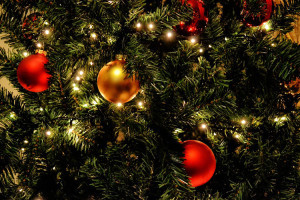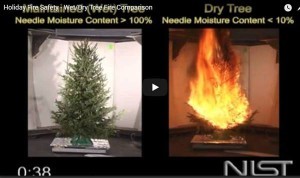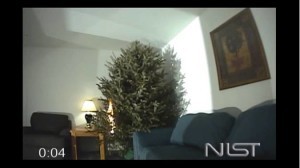
Beautiful, twinkling lights and the pine scent of a real holiday tree can be part of a cherished tradition that makes the season bright and festive for many. However, all too easily, the tree that may be decorating your living room can turn into a fire hazard that threatens your family and home.
To prevent fresh-cut trees from becoming dry and easily combustible, it is essential to keep them well watered. Check out the video from the National Institute of Standards and Technology (NIST) for a comparison of how quickly a dry tree burns versus one that has been given adequate water.
Of course, it is only logical that a dry, brittle tree will burn better than a well-watered one. From a scientific viewpoint, water primarily suppresses fire by absorbing heat. In fire tests, holiday trees have shown peak heat release rates that are roughly equivalent to the energy released by up to three burning sofas. Click photo to watch video.

In another NIST video, you can see just what happens when a dry tree catches fire. Click on photo to watch video.
As the fire flares, it takes little time for the needles to ignite. The flames quickly rise more than a couple of feet above the tree. As the fire reaches toward the ceiling, the flames draw in air from all sides, providing oxygen for the combustible gases to burn.
Next, the flames begin to spread horizontally along the ceiling; in an open setting, the fire would have more oxygen available allowing the flames to burn out in less distance. The flames advancing across the ceiling transmit the radiant heat downward toward furniture and other combustibles in the room. Jets of smoke become visible, traveling along the ceiling. At high temperatures, the soot particles in the smoke transmit a high degree of radiant energy. For radiant energy at high temperatures, a little increase in temperature can result in a large increase in heat transfer.

Flames appear in the smoke, directly above the sofa, which means the combustible gases within the smoke have ignited. The ceiling is nearly obscured by the smoke.
The end table begins to smoke from the heat created by the radiant energy of the burning tree. The armrest of the chair closest to the fire begins to smoke, even though it is not in direct contact with the flames. The radiant heat energy from the fire in the tree, as well as the flames and hot gases along the ceiling are taking their toll.
Combustible gases within the smoke begin to burn, and flames are visible directly above the armchair. An orange glow appears on the seat cushions of the sofa, indicating combustion due to the heat energy being radiated from the flames along the ceiling.
The orange glow continues to form on the armchair, first on the armrest, followed by the seat cushion and the back of the chair. The combustion on the seat of the sofa spreads to the back and expands rapidly.
The end table ignites and flames appear. Soon after, the fire on the end table spreads and you see the armchair ignite, then the sofa erupts in flames.
An orange glow overtakes the lower portion of the video, which is consistent with the onset of flashover – where everything that can burn, ignites. Through flashover, fire can engulf an entire room. It is typically associated with temperatures of about 600°C (1,112°F) and radiant heat energy of approximately 20 kW/m2.
Once flashover begins, individual elements of the fire are no longer visible, however, the glow can still be seen through the smoke and flames. The fire has raced from ignition to flashover in less than a minute.
Today’s homes typically have more combustibles than houses built just a few decades ago. Newer structures contain a lot of plastic materials, which give off intense heat and emit toxic gases when they burn. In the event of a fire, your escape time is limited.
If you have a holiday tree, take steps to protect your family and home. Be sure your tree stays well-watered, check that your smoke detectors are working properly to provide early warning, and have a plan to get out quickly if needed.
With precautions and care, you and your loved ones can have a safe and happy holiday.
Unified Investigations & Sciences, Inc., a wholly owned subsidiary of Sedgwick Claims Management Services, Inc., is a premier provider of multidisciplinary engineering and forensic investigation services to insurance carriers, corporations and public entities. Their highly experienced and licensed fire protection engineers specialize in providing insights relevant to fire cause, spread, life safety and fire detection, alarm and suppression systems.
Ron Langstaff, M.S., P.E. | Forensic Engineer
Unified Investigations & Sciences, Inc.
A Sedgwick company